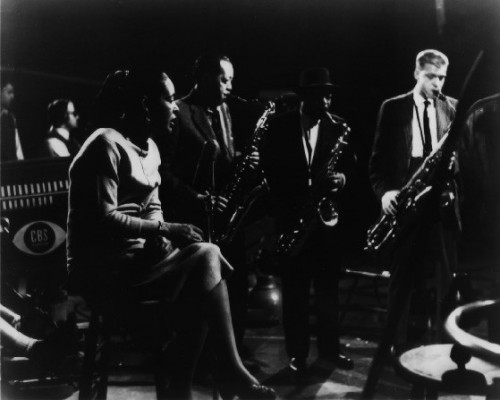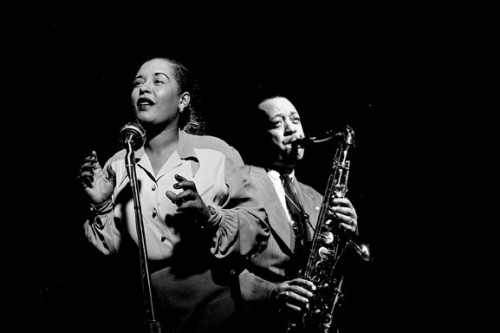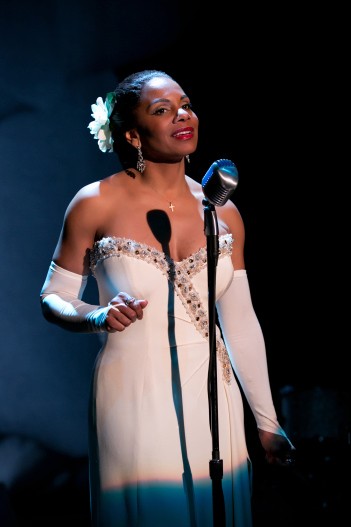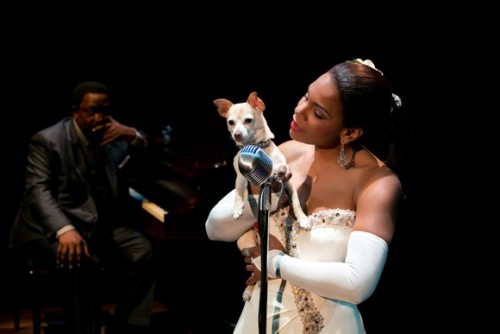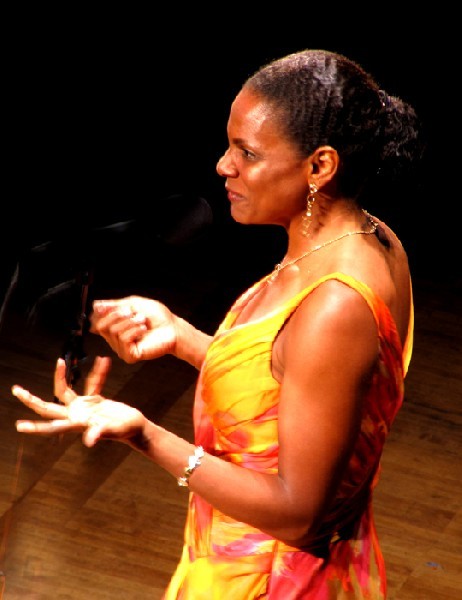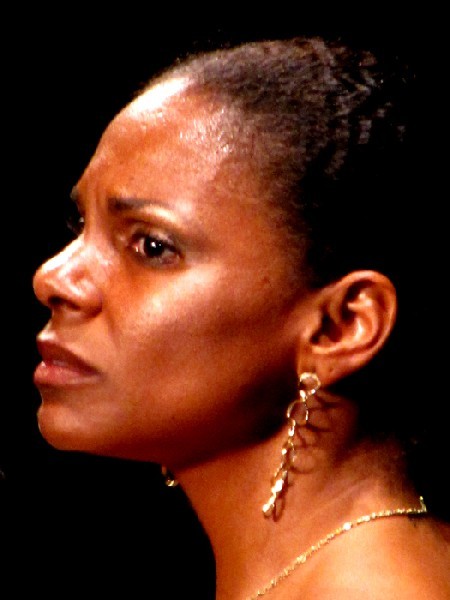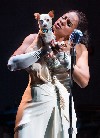Lady Day at Emerson’s Bar & Grill
Audra McDonald Evokes Jazz Legend Billie Holiday
By: Charles Giuliano - May 26, 2014
Lady Day at Emerson’s Bar & Grill
By Lanie Robertson
Directed by Lonny Price
Sets by James Noone; costumes by Esosa; lighting by Robert Wierzel; sound by Steve Canyon Kennedy; animals trained by William Berloni; technical supervision by Hudson Theatrical Associates; musical arrangements/orchestrations by Tim Weil; conductor/pianist, Shelton Becton; production stage manager, Timothy R. Semon; associate director, Matt Cowart; associate producers, Greenleaf Productions/Michael Crea and PJ Miller; company manager, Daniel Hoyos; general manager, Richards/Climan Inc.
At the Circle in the Square Theater, 1633 Broadway at 50th Street
Through June 1.
Running time: 1 hour 30 minutes.
Cast: Audra McDonald (Billie Holiday), Shelton Becton (Jimmy Powers) and Roxie (Pepi)
Billie Holiday (born Eleanora Fagan; April 7, 1915 – July 17, 1959) was arrested in the hospital as she lay dying, utterly frail and wasted from years of heroin and alcohol abuse at the age of 44. In a stunning performance Audra McDonald portrays one of her final gigs.
In the end she was broke and broken although over the years she earned lots of cash for the pimps, hustlers, husbands, family members, band leaders, managers and record companies that bilked her of every red cent. She was paid cash, short change, for numerous recording sessions but deprived of royalties, even for songs she wrote. Her music still earns money as new generations discover the greatest jazz singer of her generation.
She had a great friend and rival in Ella Fitzgerald. They dueled from time to time in epic battles of the bands; Billie fronting for Basie and Ella with drummer Chick Webb. Audiences and critics generally called it a tie.
It’s a matter of taste and style. Ella had magnificent pipes and could scat like crazy. In that regard she generally creamed her closest rival Sarah Vaughan when they went toe to toe. Nobody could keep up with Ella’s fluid invention and staggering range.
Compared to which Lady Day never had their chops. She had a stay at home technique within a narrow register delivered with impeccable timing, gut wrenching emotion, and titubating, unrivaled swing.
Ella could knock your socks off but Billie could rip your heart out and have it for lunch straight no chaser.
I can’t often listen to Billie. It’s too tough on me. I can only take it now and then. Yesterday I did to get in the mood for this piece. Too often her songs just take me down too low. Now and then you hit rock bottom. Like when my Dad died far away in Florida, Billie, Miles’s Kind of Blue, and Mahalia Jackson (Black Brown and Beige with Duke Ellington) got me through that weekend.
The first time I heard her “Strange Fruit” it broke me up and it’s still tough to listen to.
Billie can do that to you.
It was with anticipation and misgivings that I experienced Audra McDonald, one of the finest Broadway artists of her generation, in a revival of Lady Day at Emerson’s Bar & Grill.
Most recently I had heard her perform in Porgy and Bess at American Repertory Theatre prior to its Broadway run and before that in concert at Tanglewood.
While I have utter respect for her talent on every level I have never thought of her as a jazz singer. Her style and range is suited to the big stages of Broadway and the largest concert halls.
At Circle in the Square this was an intimate, scaled down evening of cabaret theater. The minimalist staging presented McDonald fronting a trio. There was café style seating in front with a bar at the other end. Prior to the performance two bartenders served drinks to the tables. There were rows of seats surrounding this area.
Several times during the play, which was largely scripted from her autobiography Lady Sings the Blues (1954 as told to William Dufty), she penetrated the space working through the cabaret audience and helping herself, generously, to the bar. At one point she bolted off stage, presumably for a fix, returning with her small dog.
At mid career, McDonald at 43 is just a year shy of Holiday’s demise at 44. By then Lady Day was frail, skeletal and clinging to what was left of life and a shattered career.
As an ex con she was denied a cabaret license to work in New York clubs. Scrounging for work she has taken a gig at a dive in Philly. “I used to tell everybody: When I die, I don’t care if I go to heaven or hell,” Holiday says, “long’s it ain’t in Philly.”
Physically McDonald is just too robustly healthy to make a totally convincing Lady Day.
Until she sings and then OMG.
Her interpretation was just perfect. Amazingly she abandoned her own incredible chops to fit into that narrow space of Billie’s slurring, throaty, wavering, breaking and cracking vibrato. She even mastered that touch of sliding notes down and out to create gut wrenching emotional twists on the lyrics of soulful ballads. Nobody can make you feel a song, even cheesy pop tunes, like Holiday.
Billie never had a great voice even in those earliest tracks (just two) with the King of Swing, Benny Goodman. As his brother in law, the Columbia Records producer John Hammond, told me during an interview Benny, a well known putz, bragged that he fucked Billie.
Not that it was unique. She got turned out in a Harlem cat house and busted for it at just 14. That was just the beginning of getting screwed in every sense during the decades that followed.
All of that horror went into her art. The rage busted out in song. Like her masterpieces “God Bless the Child’ and “Strange Fruit.” Both of which McDonald delivered with riveting intensity that coursed through me like a con strapped into old sparky.
Man that gal can sing.
But the trio didn’t do much for me. The pianist Shelton Becton (Jimmy Powers) is competent but no damn Teddy Wilson. Significantly, even at this point in the show, he was reading charts rather than improvising. To save money record companies put Billie in the studio where the band played head arrangements. They are some of the all time great recordings. Billie was meticulous about getting her sound even when cutting sides with strings.
Other than some live gigs she never recorded with Basie. But she borrowed his men for sessions. Unfortunately, not often with her great friend and former lover, tenor sax player Lester Young. They named each other Prez and Lady Day.
You have to listen to Prez before and after the Army. He was broken in the military, spent time in the brig, and was dishonorably discharged.
After that there was a heart breaking melancholy in his playing. In life and music they were truly soul mates. They didn’t speak for years until he joined her on stage at the Newport Jazz Festival.
In 1957 they appeared together in a CBS documentary The Sound of Jazz in an all star session with tenor player, Ben Webster, and Gerry Mulligan on baritone sax. In a relaxed mood Billie sings “Fine and Mellow.” When Lester solos the camera moves in on her swinging gently with body language lovingly responding to the evocative, throaty nuances of his playing.
This play presents her in a combo setting but she could front a swing band. We don’t get much of her up-tempo style but cling to “What a Little Moonbeam Can Do.” It’s a mostly slow and melancholy set with “God Bless the Child” a snippet of “Don’t Explain” “Ain’t Nobody’s Business” and the show stopping, chilling “Strange Fruit.”
It was preceded by a harrowing story of racism in the South while traveling with the white Artie Shaw band. She was reduced to taking meals in the kitchen and using freight rather than passenger elevators. Eventually she blew her stack. Denied the use of the colored men’s room by an uppity hostess McDonald acted out pissing on the kitchen floor.
That led into “Strange Fruit” a song about lynching in the South. It was written by Abel Meeropol, a Jewish schoolteacher from the Bronx. He used the pseudonym "Lewis Allan" for the poem, which was set to music and performed at teachers' union meetings. It was eventually heard by Barney Josephson, proprietor of Café Society, an integrated nightclub in Greenwich Village, who introduced it to Holiday. The recording which never was heard on the radio sold by word of mouth and generally closed her shows with a blackout from 1939 on.
When I was a teenager I saw a newspaper ad for a Holiday gig at George Wein’s Copley Square club Storyville. How I regret that I didn’t see her. By then she was ravaged.
But I’m not sure about how she is presented in this play. Based on reading her book and listening to studio and live performances, including Carnegie Hall when she was just sprung from jail, in my heart and soul, I feel a different Lady Day. One would have to research extant reviews of the late performances. Even then they are not all that revealing so one must rely on anecdotal evidence. I’m not sure that Lanie Robertson undertook that level of meticulous research in crafting this over the top play. It is dubious that Holiday would spill her guts to an audience or act in such a raucous manner.
The evening hovered between a rock and a hard place. The script was pure theatre while the singing had the authenticity of a documentary.
Often in McDonald’s performance Holiday is presented as over the top. The protest side of her feels more like the later Nina Simone than vintage Lady Day. I see Holiday as more dignified and “Lady” like than brassy and bawdy.
There is a passage taken from her book about how she listened to Bessie Smith and Satchmo records in the Harlem cat house where she initially worked as a maid. Out in the audience McDonald sang Bessie’s classic “Give Me a Pigfoot.”
With triple layering it was truly strange. This was McDonald portraying Holiday who is imitating Bessie. I’m not sure it worked. Although the audience enjoyed it.
Before the show began I asked the guy next to me if he knew much about Billie Holiday. “I saw the movie (Dianna Ross)” he said. That was probably true for most of the audience there as fans of McDonald.
Hopefully the performance has inspired them to check out the real Billie Holiday. But if you just closed your eyes and listened the sound and spirit of Billie filled the room. In that aspect it was a truly remarkable experience.

